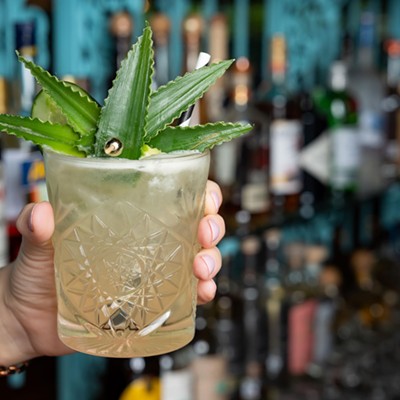Back in December, I wrote about Gelatin Clarified Stock. It's a wonderful technique, and one I still use. It is, however, slow. Due to the melting point of gelatin and the structure of the gel it sets, it requires both freezing and cold-thawing to work properly. Both of these steps take time. Fortunately, gelatin is not the only hydrocolloid on the block.
Agar, a derivative of red algae, is one such hydrocolloid. Lately, I've been exploiting a few of its particular properties in the kitchen, with some wonderful results. One of agar's benefits is the fact of its provenance. Since it doesn't come from animals, agar can be used to quickly and easily clarify vegetarian stocks and juices. I'm not vegetarian, so this fact is actually of minimal importance to me. What makes agar gel particularly appealing to me, especially in this application, is the fact that it is not as easily thermoreversible as gelatin.
Thermoreversiblity is simply the tendency of a gel structure to "melt" when heated, and is the reason that gelatin clarified stock must be drip-strained in the refrigerator. Gelatin's melting point is low enough that the weak gel used in clarification will begin to melt at room temperature, allowing the trapped particles to escape, muddying the resulting stock. Agar gels, on the other hand, are stable at much higher temperatures, not reaching their thermoreversible point until around 85c. Even in Houston, that's well above room temperature. This means that, once formed, an agar gel-clarified stock can be strained at room temperature, shaving literally days off of the prep time.
Another interesting result of the thermal properties of agar gels is the fact that they allow you to clarify a meat-based stock without the loss of gelatin that is the byproduct of gelatin clarification. Since gelatin clarification works by suspending particles in the gelatin structure, the gelatin is necessarily left behind. With agar clarification, a meat-based stock can be strained at a temperature that is above gelatin's melting point, yet below agar's. This means that the gelatin will strain out with the stock, while the particles remain suspended in the agar gel matrix. Just think, a perfectly clear meat-based consommé, complete with the rich mouthfeel of a gelatin-rich stock.
This time around, though, I decided to take my agar clarification in another direction. Mixology. Traditionally, infused alcohols are made by steeping an ingredient in a base spirit for a long period of time, imparting the flavor slowly. Other methods exist, ranging from vacuum infusion to the use of centrifuges. I don't have a vacuum chamber, and my centrifuge is busy enriching uranium, so that's out, too. Just kidding about the uranium. Fortunately, agar can solve this problem (the lack of equipment, not the lack of uranium).
I picked up a nice bottle of Austin-based Treaty Oak Platinum Rum, and decided to infuse it with the essence of roasted banana. My 750mL bottle of rum weighed out at almost exactly 700g. I puréed two roasted bananas with enough water to thin them out slightly, settling out at 300g total weight. Agar will form a weak gel at concentrations of around 2-2.5 percent, so I measured out approximately 2.5g of agar.
I heated the purée in a saucepan, with the agar thoroughly whisked in, allowing it to come to a boil for several minutes. After giving the agar enough time to fully hydrate, I removed the pan from the heat, and slowly added the rum, whisking furiously the whole time. It's important to do this fairly quickly, as the gel will begin to set prematurely if the temperature drops too much.
I poured the mix into a bowl nested into another bowl filled with ice-water, and allowed the gel to set. It took about 45 minutes. Once it was set, I beat the crap out of it with a whisking, breaking up the loose gel, and poured the result into another bowl, lined with a quadruple thickness of cheese cloth. I strained the now infused rum out of the cheesecloth through a coffee filter and then a chinois, just in case any of the agar came out while I squeezed.
I transferred the rum back to its original bottle, impressed by the yield, which must have been approaching 90 percent. I then poured it into a glass and sampled. The banana came through clearly but subtly, providing roasted back-notes, enhancing the spice and molasses flavors, and contributing just a slight grassiness. I'm eager to try my hand at some tiki creations with it.
The process only took me about an hour and a half, start to finish, and produced results that would have been impossible with gelatin clarification. Now, to clarify some fruit juice, bitters and perhaps a bit of orgeat for a perfectly clear, perfectly flavored cocktail...
Follow Eating Our Words on Facebook and on Twitter @EatingOurWords






